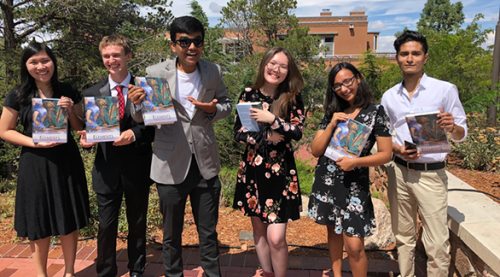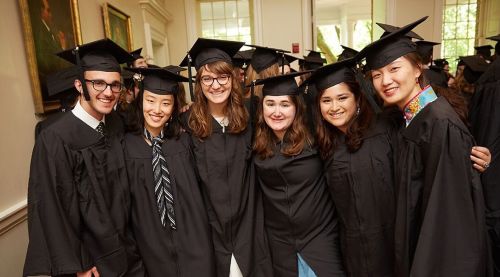
A class profile offers some basic statistics and demographics about first-year students.
St. John’s distinctive liberal arts curriculum and educational practices have long given it a highly respected place among American colleges and universities. Its strong commitment to collaborative inquiry and to the study of original texts makes St. John’s College a particularly vibrant community of learning. Through close engagement with the works of some of the world’s greatest writers and thinkers—from Homer, Plato, and Euclid to Nietzsche, Einstein, and Woolf—undergraduate and graduate students at St. John’s College grapple with fundamental questions that confront us as human beings. As they participate in lively discussions and throw themselves into the activity of translating, writing, demonstrating, conducting experiments, and analyzing musical compositions, St. John’s students learn to speak articulately, read attentively, reason effectively, and think creatively.
All classes at St. John’s College are small and students take active responsibility for their education, formulating questions and developing their thoughts in dialogue with one another. Faculty at St. John’s College share the college’s dedication to an education that privileges intellectual engagement over rigid expertise; they regard themselves as guides and mentors whose task is not to transmit information, but to pose questions that further students’ ability to develop as thinkers in their own right. Every student’s contribution receives serious consideration as classes delve into discussions of foundational works of philosophy, literature, history, theology, politics, economics, psychology, music, mathematics, and the laboratory sciences. (See more about the subjects studied at St. John’s College.)
By immersing themselves in these investigations, by examining their own ideas in conversation with faculty and fellow students, and by exploring their insights in their own written work, students acquire formidable skills and cultivate enduring habits of critical analysis and thinking. They learn to take themselves and others seriously as reasoning and feeling beings, to work together as collaborators and colleagues, and to lead fruitful lives of independent reflection and shared activity. In addition to the undergraduate program, St. John’s students may earn master of arts degrees through the Graduate Institute.
St. John’s has two spectacular campuses—one in Annapolis, Maryland, and one in Santa Fe, New Mexico. Students enrolled at either campus can transfer to the other and many students choose to spend a year at the other campus. Both campuses are situated in historic state capitals: Santa Fe hugs the slopes of the Sangre de Cristo Mountains in northern New Mexico, while Annapolis lies on the shores of College Creek, a tributary of the Chesapeake Bay in Maryland. The two campuses share the same interdisciplinary academic program, while offering a broad range of opportunities and experiences.
St. John’s College faculty are dedicated to teaching and are readily available to students. All classes are small (typically 13 to 19 students), ensuring that every student has a voice. While it can vary, the overall faculty-student ratio is 1 to 7. Paper conferences, informal study groups, the “Take a Tutor to Lunch” program, and a wide variety of extracurricular activities provide any number of occasions for students to interact with faculty members.
St. John’s College students pursue all manner of activities outside the classroom. The college has a lively theatrical tradition, a host of musical groups ranging from madrigal singers to lunch-time jam sessions, art and photography clubs, language study groups, and an energetic intramural sports program. In Annapolis, the sailing and rowing teams compete in a number of regattas each year; other intercollegiate offerings in Annapolis include the fencing team and the croquet club, which competes locally against the U.S. Naval Academy in the annual Annapolis Cup croquet match. In Santa Fe, the Search and Rescue team allows students to develop their backcountry skills and to contribute an important service to the region.
In addition, students in Santa Fe take advantage of hiking trails that begin from the college campus, skiing in the Santa Fe Ski Basin and the Taos Ski Valley, camping in the nearby Santa Fe National Forest, and the many cultural attractions of the town of Santa Fe. Students in Annapolis explore the adjacent waters, enjoy life on the town’s lively waterfront, and visit the nearby cities of Baltimore and Washington, DC. Both campuses also offer students a variety of opportunities to become involved in the life of the local community.
St. John’s typically draws students from all 50 states and many foreign countries. The diverse backgrounds and experiences they bring to the college deepen and enrich their shared investigations. (See profile of the freshman class.)
Statistics show that St. John’s College students excel in their endeavors both at the college and after graduation. Almost 70 percent of St. John’s graduates pursue advanced degrees—many enter the nation’s leading humanities, science, business, law, and medical programs. St. John’s College is in the top 2 percent of all colleges in the nation for alumni earning PhDs in the humanities, and in the top four percent for earning them in science or engineering. (See more rankings.)
One of the many striking features of St. John’s College, however, is that there is no typical St. John’s graduate: St. John’s graduates pursue all manner of careers. They become authors, winemakers, musicians, filmmakers, teachers, astrophysicists—whatever they choose!
As students work in and across disciplines, wrestling with philosophic, literary, musical, mathematical, and scientific texts, they acquire habits of mental flexibility and focus, develop their powers of intellect and imagination—and so become effective problem solvers, leaders, thinkers, and communicators. St. John’s College alumni span the globe as learners and leaders, as individuals passionate in their pursuit of truth.
St. John’s is a coeducational, liberal arts college with no religious affiliation.
Bachelor of Arts (BA) degree in Liberal Arts, both campuses
Master of Arts (MA) in Liberal Arts, both campuses
Master of Arts (MA) in Eastern Classics, Santa Fe only
St. John's College offers no programs leading to professional licensure.
St. John’s College in Annapolis is accredited by the Middle States Association of Colleges and Schools; St. John’s in Santa Fe is accredited by the Higher Learning Commission.
Additional information about St. John’s, including student outcomes, may be found on the College Navigator profile for Annapolis and the College Navigator profile for Santa Fe.
To view St. John’s College accreditation and state approval documentation:
Contact the president’s office on campus to make an appointment.
To file a complaint related to accreditation:
Submit a formal complaint to Middle States Association of Colleges and Schools or the Higher Learning Commission.
For those who have filed a complaint with St. John’s College—using the procedures stated in the student handbook—but have been unable to resolve the complaint at the institutional level, they may submit a complaint to the appropriate St. John’s College state approval entity:

A class profile offers some basic statistics and demographics about first-year students.

St. John’s College is proud to be included in Colleges That Change Lives, a book written by Loren Pope and first published in 1996. The list of 40 schools features distinct institutions of higher learning that offer an alternative to traditional university education.